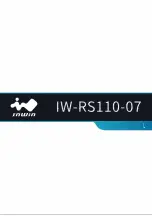
62
Troubleshooting
• Flashing at 1/10 second on and 9/10 second off – Cache is being refreshed by the supercapacitor.
• Off – Cache is clean (no unwritten data).
4.
Reseat the host cable and inspect for damage.
Is the host link status LED on?
• Yes – Monitor the status to ensure that there is no intermittent error present. If the fault occurs again,
clean the connections to ensure that a dirty connector is not interfering with the data path.
• No – Proceed to the next step.
5.
Move the host cable to a port with a known good link status.
This step isolates the problem to the external data path (host cable and host-side devices) or to the
controller module port.
Is the host link status LED on?
• Yes – You now know that the host cable and host-side devices are functioning properly. Return the
cable to the original port. If the link status LED remains off, you have isolated the fault to the
controller module port. Replace the controller module.
• No – Proceed to the next step.
6.
Verify that the switch, if any, is operating properly. If possible, test with another port.
7.
Verify that the HBA is fully seated, and that the PCI slot is powered on and operational.
8.
Replace the HBA with a known good HBA, or move the host side cable to a known good HBA.
Is the host link status LED on?
• Yes – You have isolated the fault to the HBA. Replace the HBA.
• No – It is likely that the controller module needs to be replaced.
9.
Move the host cable back to its original port.
Is the host link status LED on?
• No – The controller module port has failed. Replace the controller module.
• Yes – Monitor the connection for a period of time. It may be an intermittent problem, which can
occur with damaged cables and HBAs.
Isolating a controller module expansion port connection fault
During normal operation, when a controller module expansion port is connected to a drive enclosure, the
expansion port status LED is green. If the connected port’s expansion port LED is off, the link is down. Use
the following procedure to isolate the fault.
This procedure requires scheduled downtime.
NOTE:
Do not perform more than one step at a time. Changing more than one variable at a time can
complicate the troubleshooting process.
1.
Halt all I/O to the storage system as described in
2.
Check the host activity LED.
If there is activity, halt all applications that access the storage system.
3.
Check the Cache Status LED to verify that the controller cached data is flushed to the disk drives.
• Solid – Cache contains data yet to be written to the disk.
• Blinking – Cache data is being written to CompactFlash.
• Flashing at 1/10 second on and 9/10 second off – Cache is being refreshed by the supercapacitor.
• Off – Cache is clean (no unwritten data).
4.
Reseat the expansion cable, and inspect it for damage.
Is the expansion port status LED on?
• Yes – Monitor the status to ensure there is no intermittent error present. If the fault occurs again,
clean the connections to ensure that a dirty connector is not interfering with the data path.
• No – Proceed to the next step.
Содержание MSA 2040
Страница 8: ...8 Figures ...
Страница 10: ...10 Tables ...
Страница 32: ...32 Installing the enclosures ...
Страница 44: ...44 Connecting hosts ...
Страница 50: ...50 Connecting to the controller CLI port ...
Страница 52: ...52 Basic operation ...
Страница 70: ...70 Troubleshooting ...
Страница 74: ...74 Support and other resources ...
Страница 76: ...76 Documentation feedback ...
Страница 88: ...88 LED descriptions ...
Страница 94: ...94 Electrostatic discharge ...
Страница 100: ...100 Index ...


































